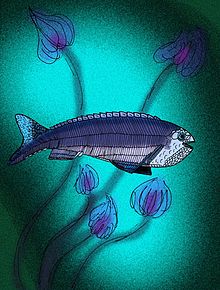| Anaspida Temporal range: early Silurian - Late Devonian
| |
|---|---|

| |
| Cowielepis | |
| Scientific classification | |
| Domain: | Eukaryota |
| Kingdom: | Animalia |
| Phylum: | Chordata |
| Superclass: | †Anaspidomorphi |
| Class: | †Anaspida Traquair, 1899 |
| Type species | |
| †Birkenia elegans Traquair 1898
| |
| Orders | |
| Synonyms | |
| |

Anaspida ("shieldless ones") is an extinct group of jawless fish that existed from the early Silurian period to the late Devonian period.[2] They were classically regarded as the ancestors of lampreys,[3] but it is denied in recent phylogenetic analysis,[4] although some analysis show these group would be at least related.[5] Anaspids were small marine fish that lacked a heavy bony shield and paired fins, but were distinctively hypocercal.
- ^ Janvier, Philippe (1997) Anaspida The Tree of Life Web Project.
- ^ Ahlberg, Per Erik (2001). Major events in early vertebrate evolution: palaeontology, phylogeny, genetics, and development. Washington, DC: Taylor & Francis. p. 188. ISBN 0-415-23370-4.
- ^ Patterson, Colin (1987). Molecules and morphology in evolution: conflict or compromise?. Cambridge, UK: Cambridge University Press. p. 142. ISBN 0-521-32271-5.
- ^ Keating, Joseph N.; Donoghue, Philip C. J. (2016-03-16). "Histology and affinity of anaspids, and the early evolution of the vertebrate dermal skeleton". Proceedings of the Royal Society B: Biological Sciences. 283 (1826): 20152917. doi:10.1098/rspb.2015.2917. ISSN 0962-8452. PMC 4810860.
- ^ Cite error: The named reference
:0was invoked but never defined (see the help page).